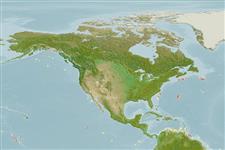Deepstaria reticulum Lerson, Madin & Harbison, 1988
| Native range | All suitable habitat | Point map | Year 2050 |

|
| This map was computer-generated and has not yet been reviewed. |
| Deepstaria reticulum AquaMaps Data sources: GBIF OBIS |
Google image |
No photo available for this species.
Classification / Names Κοινά ονόματα | Συνώνυμα | CoL | ITIS | WoRMS
Scyphozoa | Semaeostomeae | Ulmaridae
Environment: milieu / climate zone / εύρος βάθους / distribution range Οικολογία
Πελαγικό(ά); εύρος βάθους 600 - 915 m (Αναφ. 3634). Tropical; 72°N - 25°N, 95°W - 26°E
Distribution Χώρες | Περιοχές FAO | Οικοσυστήματα | Παρουσίες | Εισαγωγές
Arctic and Atlantic Ocean: from Hudson Complex, to Baffin Bay, north to Norway and south to Canary Island.
Length at first maturity / Μέγεθος / Weight / Age
Γεννητική Ωρίμανση: Lm ? range ? - ? cm Max length : 75.0 cm WD αρσενικό/απροσδιόριστο; (Αναφ. 121705)
Life cycle and mating behavior Γεννητική Ωρίμανση | Αναπαραγωγή | Γεννοβολία | Eggs | Γονιμότητα | Larvae
Main reference
Αναφορές | Συντονιστής | Συνεργάτες
Larson, R.J., L.P. Madin and G.R. Harbison 1988 In situ observation of deepwater medusae in the genus Deepstaria, with a description of Deepstaria reticulum, sp. nov.. Journal of Biological Association of the United Kingdom. 68(4):689-699. (Αναφ. 3634)
IUCN Red List Status
(Αναφ. 130435: Version 2025-1)
CITES status (Αναφ. 108899)
CMS (Αναφ. 116361)
Threat to humans
Human uses
| FishSource |
Εργαλεία
Περισσότερες πληροφορίες
Σύσταση δίαιτας
Κατανάλωση τροφής
Θηρευτές
Max. ages / sizes
Length-weight rel.
Length-length rel.
Length-frequencies
Mass conversion
Αφθονία
Διαδικτυακές πηγές
BHL | BOLD Systems | CISTI | DiscoverLife | FAO(Publication : search) | Fishipedia | GenBank (genome, nucleotide) | GloBI | Gomexsi | Google Books | Google Scholar | Google | PubMed | Δέντρο Ζωής | Wikipedia (Go, αναζήτηση) | Zoological Record


